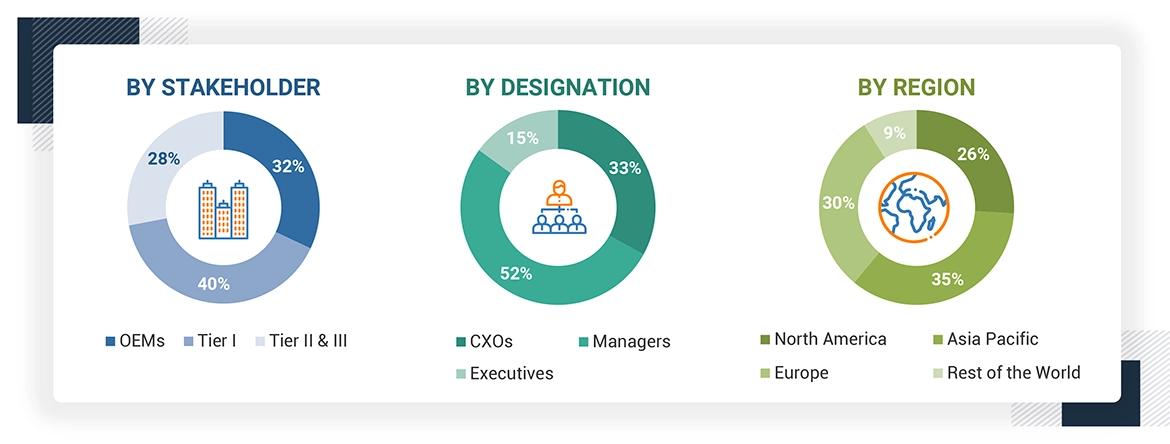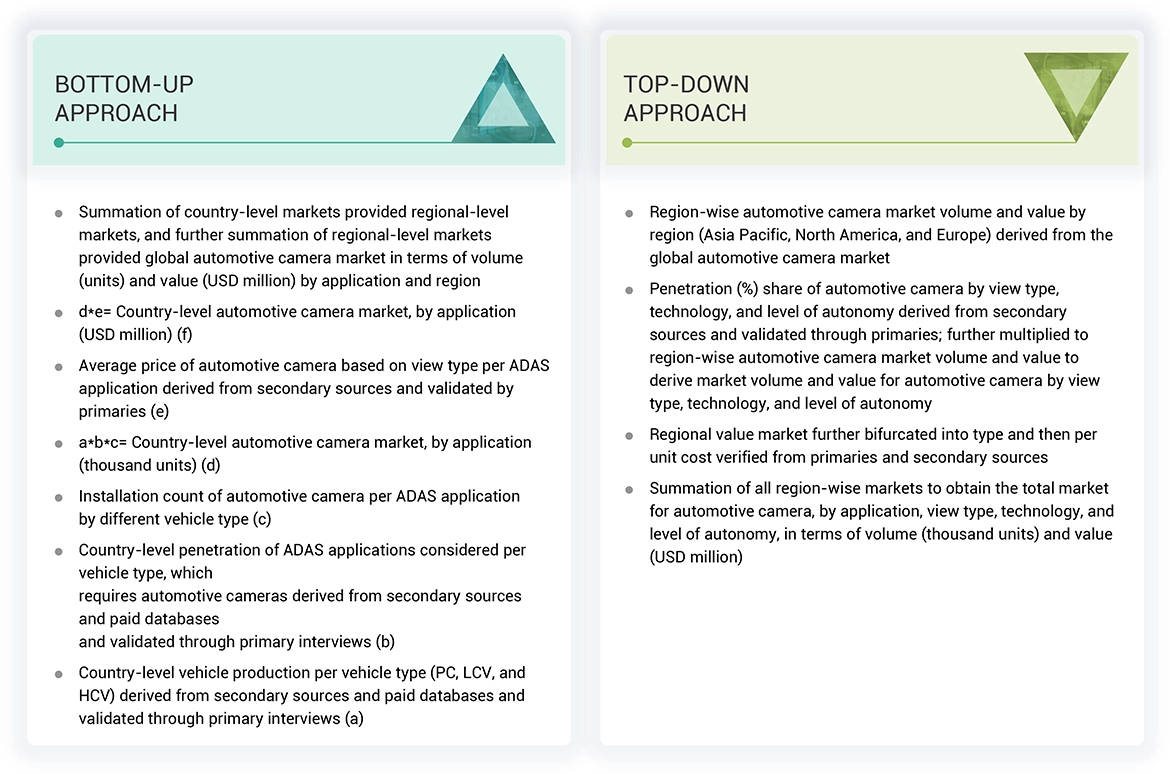The study involved four major activities to estimate the current size of the automotive camera market. Exhaustive secondary research collected information on the market, the peer market, and model mapping. The next step was to validate these findings and assumptions and size them with industry experts across value chains through primary research. The bottom-up and top-down approaches were employed to estimate the total market size. After that, market breakdown and data triangulation were used to determine the market size of segments and subsegments.
Secondary Research
In the secondary research process, various secondary sources were used to identify and collect information on the automotive camera market for this study. Secondary sources for this research study include corporate filings, such as annual reports, investor presentations, and financial statements; trade, business, and professional associations; whitepapers and automotive software-related journals; certified publications; articles by recognized authors; directories; and databases. Secondary research has been used to obtain key information about the industry's supply chain, the overall pool of key players, market classification and segmentation according to industry trends to the bottom-most level, regional markets, and key developments from the market- and technology-oriented perspectives.
Primary Research
Extensive primary research has been conducted after understanding the automotive camera market scenario through secondary research. Several primary interviews have been conducted with market experts from demand-side automotive camera providers and supply-side OEMs across four major regions: North America, Europe, Asia Pacific, and Rest of the World. Approximately 24% and 76% of primary interviews have been conducted from the demand and supply sides, respectively. Primary data was collected through questionnaires, emails, and telephonic interviews. In the canvassing of primaries, various departments within organizations, such as sales, operations, and marketing, were covered to provide a holistic viewpoint in the report..
After interacting with industry experts, we also conducted brief sessions with highly experienced independent consultants to reinforce the findings from our primaries. This, along with the in-house subject matter expert opinions, led us to the findings as described in the remainder of this report.

Note: Tiers of companies are based on the supply chain of the automotive camera market; companies’ revenues have not been considered.
About the assumptions considered for the study, To know download the pdf brochure
Market Size Estimation
A detailed market estimation approach has been followed to analyze and validate the value and volume of the automotive camera market and other dependent submarkets. Key players in the automotive camera market have been identified through secondary research, and their global market shares have been determined through primary and secondary research. The research methodology includes the study of the annual and quarterly financial reports & regulatory filings of major market players, as well as interviews with industry experts for detailed market insights. All major penetration rates, percentage shares, splits, and breakdowns for the automotive camera market have been determined using secondary sources and model mapping and verified through primary sources. All key macro indicators affecting the revenue growth of the market segments and subsegments have been accounted for, viewed in extensive detail, verified through primary research, and analyzed to get the validated and verified quantitative & qualitative data. The gathered market data has been consolidated and added with detailed inputs, analyzed, and presented in this report.

Data Triangulation
All percentage shares, splits, and breakdowns have been determined using secondary sources and verified by primary sources. All parameters that affect the markets covered in this research study have been accounted for, viewed in extensive detail, and analyzed to obtain the final quantitative and qualitative data. This data has been consolidated, enhanced with detailed inputs and analysis from MarketsandMarkets, and presented in the report. The following figure is an illustrative representation of the overall market size estimation process employed for this study.
Market Definition
Automotive Camera: A camera is a device that records visual images in the form of photographs, film, or video signals. In the automotive sector, the camera is used as an advanced safety device for enhancing the visibility of the surrounding environment of a driver to improve vehicle safety. An automotive camera records images through lenses and converts them into electrical signals. The growing demand for advanced driver assist systems (ADAS) in developed and emerging economies is attributed to the use of cameras in various applications such as park assist, cross-traffic alert, and pedestrian detection systems.
Stakeholders
-
ADAS Integrators
-
Automotive Camera Component Manufacturers
-
Automotive Camera Manufacturers
-
Automotive Software and Platform Providers
-
Autonomous Driving Platform Providers
-
Government and Research Organizations
-
National Highway Traffic Safety Administration (NHTSA)
-
Raw Material Suppliers for Automotive Cameras
-
Transport Authorities
-
Vehicle Safety Regulatory Bodies
Report Objectives
-
To segment and forecast the size of the global automotive camera market by value & volume based on technology (Digital, Infrared, and Thermal)
-
To segment and forecast the size of the global automotive camera market, by value & volume, based on ICE application (Adaptive Cruise Control; Adaptive Cruise Control + Forward Collision Warning; Adaptive Cruise Control + Forward Collision Warning + Traffic Sign Recognition; Blind Spot Detection; Blind Spot Detection + Lane Keep Assist + Lane Departure Warning; Adaptive Lighting System; Intelligent Park Assist; Driver Monitoring System; Night Vision System; Parking Assist)
-
To segment and forecast the size of the global automotive camera market by value & volume based on vehicle type (ICE) (Passenger Car, Light Commercial Vehicle, Heavy Commercial Vehicle)
-
To segment and forecast the size of the global automotive camera market by value & volume based on view type (Front View, Surround View, and Rear View)
-
To segment and forecast the size of the global automotive camera market by value, based on EV type [Battery Electric Vehicle (BEV), Plug-in Hybrid Electric Vehicle (PHEV), Fuel Cell Electric Vehicle (FCEV)]
-
To segment and forecast the size of the global automotive camera market, by value & volume, based on EV application (Adaptive Cruise Control; Adaptive Cruise Control + Forward Collision Warning; Adaptive Cruise Control + Forward Collision Warning + Traffic Sign Recognition; Blind Spot Detection; Blind Spot Detection + Lane Keep Assist + Lane Departure Warning; Adaptive Lighting Systems; Intelligent Park Assist; Driver Monitoring Systems; Night Vision Systems; Parking Assist)
-
To segment and forecast the size of the global automotive camera market by value, based on level of autonomy (Level 1, Level 2 & Level 3, and Level 4/ Level 5)
-
To segment and forecast the size of the automotive camera market, by value & volume, based on region (Asia Pacific, Europe, North America, and Rest of the World)



Growth opportunities and latent adjacency in Automotive Camera Market